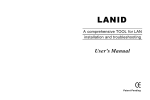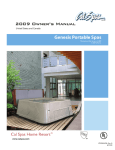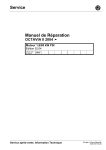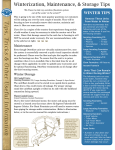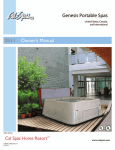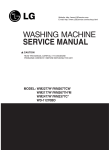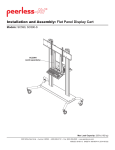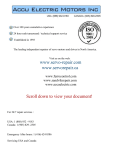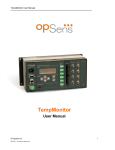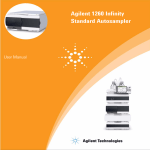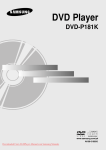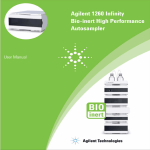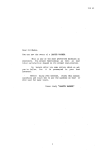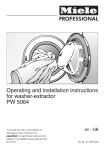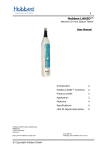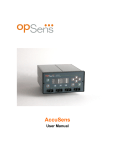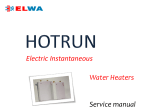Download S.C. M.
Transcript
C. M . S. Te c nol ogi e SUBMERSIBLE AERATORS Wastewater Treatment Aeration & Mixing INDEX 1. General information Page 03 1.1 Use of symbols 03 1.2 General conditions 03 1.3 Example of data plate 04 1.4 Operating instructions 05 2. Safety 05 3. Description of the product and use 06 3.1 Technical, characteristics, function and use 06 3.2 Marginal notes to take into consideration 07 4. Handling and storage 08 5. Installation 08 5.1 Preliminary inspections 08 5.2 Electrical connections 10 6. Directions of use and maintenance 11 6.1 Start 11 6.2 Running and inspections 11 6.3 Maintenance 12 6.4 Out of use/Inactivity 14 7. To take out of use and dismount 14 8. Warranty 14 9. Causes of irregular function - troubleshooters 15-16 Nomenclature / Typical sections 17-28 1 SUBMERGED RADIAL AERATOR TYPES SC and SC/L The picture is illustrative and not binding for S.C.M. Tecnologie User’s manual 2 1. GENERAL INFORMATION 1.1 USE OF SYMBOLS The instructions in this manual concerning safety are marked by this symbol. Your disrespect and failure to follow these instructions might expose staff to health risks. Furthermore the instructions in this manual concerning electrical hazards are marked by this symbol. Your disrespect and failure to follow these instructions might expose staff to risks of electrical nature. ATTENTION The instructions preceded by this word concern the main recommendations for correct installation, operation, preservation and dismountation of the electric aerator itself. To ensure safe and reliable management of the electric aerator throughout its useful life, you must follow all indications in this manual. Read the use and maintenance manual. 1.2 GENERAL CONDITIONS Check that the items indicated on the consignment note correspond to those you actually received and that these have not been damaged. Before you proceed working on the aerator, please become fully familiar with all the instructions given in the supplied documentation. The manual and all the supplied documents, including a copy of the data plates, form an integral part of the aerator in use. For example, the additional data plates can be attached to the user's manual. No part of these documents may be duplicated in any form unless prior authorization has been obtained from the manufacturer. 3 1.3 EXEMPLIFICATION OF DATA PLATE A B C E F H D I L G A Type of equipment and serial number B Date C Type of equipment D Nominal mains voltage E Maximum absorbed current F Type of connection G Maximum power absorption H Frequency I Rotation speed L Class of motor protection The manufacturer reserves his right to modify the technical characteristics without previous notice. 4 1.4 OPERATING INSTRUCTIONS Become thoroughly familiar with the instructions in the documents consigned with the aerator. This will enable you to work in complete safety and to obtain the best performance the aerator is capable to offer. The following instructions apply to the standard version of the aerator in normal conditions. Special versions, shown by the product code, may not fully comply with the indications herein (when necessary, the manual will be supplied with additional information). In correspondence with our policy of constant development and improvement of our products, the data in the documentation and the product itself may be subjects to modification without further notice from the manufacturer. The disrespect of all the instructions in this manual or an inappropriate use or unauthorized modifications to the aerator unit will void all forms of guarantee, while the manufacturer shall not be held responsible for any damages of any kind to persons, animals or property. 2. SAFETY : Before proceeding with any form of operation on the product, always make sure that the electrical parts of the system that you work on are not connected to electrical power. The submerged radial aerator described in this manual is for industrial use, for building sites or permanent use at home. As such, the maintenance of the product in form of service, reparation or dismountation must be carried out by specialized staff possessing appropriate qualifications and equipped with adequate tools. The handling, installation and management of the product may also be carried out by non-specialized staff on the conditions that they have become fully familiar with the contents of this manual and any other documentation supplied with the product. Always comply with all safety accident-prevention and anti-pollution instructions in the manual during each individual operation, together with all the more restrictive local provisions in merit. 5 Since the nature of the aerated liquids varies, it may be necessary to wear appropriate clothing to protect your skin from contact with the same. For safety reasons and to ensure compliance with the warranty conditions, the purchaser is forbidden to use the aerator should this become faulty or in the event of a sudden variation in the performances of the aerator itself. Installation must be such as to prevent accidental contacts which could represent a hazard for persons, animals and property. Inspections and servicing procedures must be carried out to prevent all forms of risk following malfunction of the aerator unit. Consult the “Handling and storage“ chapter for safe handling and storage. 3. DESCRIPTION OF THE PRODUCT AND USE : 3.1 TECHNICAL CHARACTERISTICS, CHARACTERISTICS, FUNCTION AND USE: (SEE PICTURE AND TABLE ON PAGES 25/26) The SC submerged aerators are an extremely flexible and versatile airing system for the t r e a t m e n t o f wa s t ewa t e r a n d w h e n eve r m i x i n g w i t h a i r i s r e q u i r e d Elevated oxygen transfer values, low noise levels, high reliability, low costs and ease of installation are just some of the advantages that our SC submerged aerators offer. Moreover, they can be powered by atmospheric air, pure oxygen enriched air or by pure oxygen alone without having to install complicated and expensive air diffusion systems. The submersed aerator consists of a submerged motor which activates an impeller. The rotation of the impeller creates a void in the compartment of the same, thus allowing aspiration of air from a special aspiration chamber. The air and liquid are mixed with a great strength in the expulsion channels from where the expelled jet causes a remarkable mixing of the liquid. 6 The SC submerged aerator evidently provides an elevated performance in the transfer of oxygen and increased mixing ability. In addition, working as it does on the bottom of the tank, it permits a total airing of the waste water avoiding dead zones which are characteristic of other systems. The asynchronous electric motor with squirrel cage rotor is submersible featuring protection degree IP68. All versions have nuts and bolts and drive shaft in stainless steel, which guarantee a reliable operation even when moderately aggressive fluids are aerated. For the installation of the SC submerged aerator, it is sufficient to put the aerator on the bottom of the tank (see picture 1 page 23) without the help of any anchorage and support structures. The weight of the machine itself and its low centre of gravity ensure a high stability. A chain (see picture 2 page 24) locked to the machine and fixed to the intake pipe, allows an easy handling of the SC submerged aerator and avoids using any expensive gangways or emptying of the tank (see picture 5 page 28). When the product is installed according to the instructions given in this manual and in compliance with the diagrams, the acoustic pressure level caused by the machine within the given field of operation will never exceed 70 dB (A). Noise measurement was conducted in compliance with ISO 3746 and, according to 89/392/EU Regulations. The gauging points were 1 meter from the reference surface of the machine and 1.6 metres from ground or access platform level. The maximum value is evenly distributed around the unit. 3.2 MARGINAL NOTES TO TAKE INTO CONSIDERATION ATTENTION The SC submerged aerators are not suitable for: - Dry operation; - Aeration or mixing of liquids at a temperature exceeding 40°C (104°F); - An immersion depth inferior or superior to the minimum or maximum values indicated in the graphs attached to this manual; - Aeration or mixing of liquids with a pH value of other than 6,5÷8,5 (in case of different pH values, special versions are produced on request); - Aeration or mixing of inflammable liquids; - Operation in places with a classified risk of explosion. 7 4. STORAGE AND HANDLING Store the product in a dry and dust-free place. Avoid instability which could be caused by improper positioning of the product. Turn the rotating parts at regular intervals to prevent them from possible jamming (consult the “Preliminary inspections” chapter for relative procedure). WARNING: BEWARE OF NOT CAUSING ANY DAMAGE TO THE ELECTRIC CABLE WHEN HANDLING THE AERATOR (SEE PICTURE 1 PAGE 23). ATTENTION For a safe storage after previous installation, the product must be thoroughly cleaned (do not ever use hydrocarbon based products for this purpose). The submerged aerator must be handled with care. Use suitable lifting means in compliance with the safety provisions in merit, gripping the product by the relative lifting points (handles, eyebolts). (SEE PICTURE 2 PAGE 24). Do not ever use the powering and grounding cables for handling purposes. Do not bend the cables sharply (the minimum radius of the bend must be more than 5 times the diameter of the cable itself). The extreme ends of the cables must never be immersed or wetted in any way. 5. INSTALLATION : (FIG.1 PAGE 23 FIG. 5 PAGE 28) 5.1 PRELIMINARY INSPECTIONS : • Check that the machine did not suffer damages during transport; • Install the aerators in a position as vertical as possible. The use of the aerator in a non-vertical position causes a more serious wear and tear of the rotating parts. • Do not submerge the extreme ends of the cable and do not use the cable to lift or lower the aerator; use the special chain instead. The disrespect of these rules may lead to water in the cable or broken wires on the internal , causing a motor out of order. 8 • If the cable must be extended do as follows: - handle the joint carefully and avoid submerging it; - do not extend the cable more than the necessary length choosing a suitable dimension of the cable. A voltage drop may occur if the cable is too long or if the dimension is too small, so as to give you problems to start the motor. • The installation depth has a great importance for the conditions of the motor. The more the quantity of water increases the more the motor has to work. For safety reasons do not exceed the following depths: 3,5 5,0 5,5 5,5 6,5 6,5 m.c.a. m.c.a. m.c.a. m.c.a. m.c.a. m.c.a. : : : : : : SC SC SC SC SC SC 10 30 55 75 100 120 6,5 7 7 10 10 10 m.c.a. m.c.a. m.c.a. m.c.a. m.c.a. m.c.a. : : : : : : SC SC SC SC SC SC 180 220 300 400 500 800 - Verify that the aerator is not in use until the motor is completely submerged by the liquid to be aerated, otherwise a superheating of the motor will occur. - You are advised to install the aerator in square or round tanks; if they are rectangular it will be better to use lower power aerators. Alternatively we suggest using SC aerators together with SC mixers in order to avoid the stagnation of the liquid to be aerated into the basins. - After a period of inactivity, check that the aerator contains the right quantity of oil. When it is not the first installation, also check that there are no impurities and/or water (consult the “Maintenance” chapter). Before connecting the aerator to the electrical power, verify by hand that the impeller has free rotation. ATTENTION: Do never ever carry out this operation when the aerator is electrically connected and before having checked the free rotation of the impeller when the motor is put on a suitable floor. (SEE TABLE WITH WEIGHTS TABLE ON PAGE 25/26). Specialised and authorised staff will carry out the electrical connections of the power cable to the control panels, which is equipped with all the suitable thermal and electrical protections. The very same spacialised staff will verify that the rotation sense is clockwise. 9 ATTENTION: The rotation sense can be checked visually. You must keep 1 metre distance from the aerator, wear suitable clothes and never touch the machine. (picture 4) 5.2 ELECTRICAL CONNECTIONS (SEE PICTURE ON PAGES 17/18/19/20). Do not never ever open the motor of the aerator. Call qualified staff if necessary. The whole electric installation must be carried out by qualified personnel who strictly comply with all the current accident-prevention provisions in force. The aerators must be equipped with motors with a voltage rating of 220,380,415,500 or 550V. Always indicate for what voltage for the motor is prepared and if the starting must be direct or star/delta. Always verify that the supply voltage agrees with the specifications indicated on the rating plate of the aerator. As the motor of aerator is submerged, it must necessarily be connected to the grounding circuit. The grounding conductors are yellow/green. All yellow/green conductors must be connected to the grounding circuit of the system before the other conductors are connected. The grounding conductors must be the last to be removed if the motor is disconnected. The extreme ends of the cables must not ever in any situation be immersed or be in contact with water. Remember that the current intensity needed for the direct starting is 6 times the nominal one, while in case of star/delta starting it is twice; make sure that the fuses are able to tolerate this starting intensity. Control panel The control panel can be made up by a normal motor protector in case of direct starting or by a star/delta aviator supplied with a motor protector relay. Direct start: the motor protector must be adjusted at a current-carrying capacity equivalent to the one on the rating plate. 10 Star/delta start: adjust the thermal relay to a current-carrying capacity equivalent at the latest to 0,58 times the nominal absorption indicated on the rating plate. If the motor protector goes off while the aerator is working, check the fuses before trying to start it again. Do not ever force the aerator to work without having solved the problems. If necessary consult a technician of S.C.M. Tecnologie. Direction of rotation After every new connection and lack of voltage check the rotation direction of the motor (SEE PICTURE 4 ON PAGE 27). The rotation direction of the impeller must be clockwise when watching the aerator from the top (in case connect the machine and check its rotation direction before submerging it). If the rotation direction is wrong, the motor does not aspirate air correctly, causing an overcharge with current absorption. If this rotation direction is wrong you need to invert the two ends of the cable on the control panel. (CONSULT THE PARAGRAPH 5.1-PAG. 8). 6. USE AND MAINTENANCE 6.1 START If the starting unit is unable to start, do not insist repetedly as this could only damage the component. Identify the malfunction and repair the damage. If an indirect starting system is used, the starting transaction must be brief never more than a few seconds. 6.2 RUNNING AND INSPECTIONS ATTENTION: Once installed, the SC aerator will not require particular maintenance. However to ensure a continuous regular operation check periodically that the aerator hydraulics are not clogged by solids and/or thready substances in the pump liquid. Also conduct regular preventive maintenance inspections at least once every 5,000-10,000 hours service depending on whether duty is more or less heavy. Check the following: - The electrical insulation of the motor-power cable complex (consult the “Electrical connections" paragraph); - The condition of the oil (consult the “Maintenance” paragraph); - The condition of the hydraulic components (consult the “Maintenance” paragraph); You are also advised to check the efficiency of the electric panel (when installed) every 6-12 months. If operative faults are detected, identify their causes and proceed with repairs, as indicated in this manual. 11 6.3 MAINTENANCE Routine maintenance and repairs must be carried out by specialized technicians in possession of adequate qualifications and equipped with the right tools. These technicians must have become fully familiar with the contents of this manual and with any other documentation supplied with the product. After having dismantled the aerator for the repair, please apply to the fastening moments of the bolts on page 27 for a correct assembling. Extraordinary maintenance must only be carried out by authorized workshops. Check of the mechanical seal During the check of the mechanical seal, you must make sure that no abnormal infiltrations occurred in both the seals. You must also check that no other liquids have entered the stator and the oil tank. If the aerator or the seal is new, you are advised to have everything overhauled after a week of work. In case of normal functioning, examine the aerator at least once a year. If the aerator operates in intensive conditions, make sure it is overhauled more frequently. Oil inspection Put the aerator on its supports and remove the fill-drain screw with a suitable key, putting the oil in a container. If only oil comes out, this means that the seal is intact. Make also sure that the oil quantity has not considerably decreased, then pour the oil into the tank again. If the oil appears lightly grey-yellowish and viscous or there is a water presence, it means that the seal bearing or the seal are damaged and they have to be replaced. In this case the aerator must be taken to a workshop for a general revision. Fill in the tank with AGIP ITE 360 oil (from 0,6lt to 4lt according to type). Tighten the blowdown and the filling screws. Replace the grommets under the screws. These operations must be carried out by authorized workshops or at S.C.M. Tecnologie. General revision Considering the presence of spherical bearings, the aerator needs a general revision every three years. Take voltage from the aerator and disconnect the electric cable from the closest cutout box or the control panel. 12 Take the aerator out of the basin using the suitable chain; it is not necessary to unscrew any bolts or screws. Clean the aerator with a jet of water. Now the aerator is ready to be taken to the workshop for the revision. Disassemble the aerator in all its parts, clean all the seal surfaces and check their integrity. Replace the damaged parts; clean and lubricate the spherical bearings. Replace the inferior seal bearing if the water or the mixture water-oil has penetrated into the stator. These operation must be carried out by specialized staff, by an authorized workshop or at S.C.M. Tecnologie. Check the electric motor insulation During the general revision, you are advised to check the insulation of the motor with a megohmmeter at 500V. The insulation has to result superior to 1 megohm whether in the different phases or between each phase and the aerator. Lubrication The bearings installed on the aerators are RS or 2Z self-lubricating for life, therefore they do not need to be periodically lubricated. It is advisable to check their state of wear and tear. These operation must be carried out by specialized staff, by an authorized workshop or at S.C.M. Tecnologie. Unscrew the oil plug, put the oil in a clean container and check it. Fill in the oil tank with AGIP ITE 360 or equivalent. Quantity of oil contained into the motors of the SC-SC/L aerators and submersible mixers. Aerator model Kw Q. Litres SC 10 SC 10/L G408T SC 10 SC 10/L G409T SC 30 SC 30/L G410T SC 55-75 SC 55/L-75/L G411T SC 100-120 SC 100/L-120/L G413T SC 10 SC 10/L G418T SC 10 SC 10/L G420T SC 10 SC 10/L G425T MX-gb 19.24.4 MX-gb 19.32.4 MX-gi 30.15.6 MX-gi 30.22.6 MX-ii 40.25.8 MX-ii 40.30.8 MX-ii 40.50.8 MX-ii 60.50.12 MX-ii 60.75.12 MX-ii 60.100.12 1,5 3 4 5,5 - 9 11-15 18 -30 37-55 80 2,4 3,2 1,5 2,2 2,5 3 5 5 7,5 10 0,33 0,33 1,2 1,7 1,5 2,85 1,5 1,5 0,45 0,45 0,33 0,33 0,5 0,5 0,5 1,5 1,5 1,5 Oil: DIELECTRIC AGIP ITE 360 OR EQUIVALENT 13 Checking the impeller and the suction plug If the air volume decreases: a - Check that the impeller or the suction plug are not clogged and remove possible clogging materials. b - Replace the impeller and/or the suction plug and/or the bushing seal of the impeller. In case they would be damaged, consult S.C.M. Tecnologie. Check the air input Check the air input pipe is not clogged or damaged, which both can cause a motor overload. Check that the throttle valve (when installed) is in good conditions. Check that the silencer (when installed) is dust-free, if not clean it from dust. All the described checks must be periodically carried out to extend the useful life of the aerator. 6.4 INACTIVITY: Consult the “Storage and handling chapter” 7. TO TAKE OUT OF USE AND DISMOUNT: When dismantling the aerator, the technician must proceed with the relative phases in strictly following the local rules and regulations governing such activity. 8. WARRANTY The general conditions for sale of all products manufactured by S.C.M. Tecnologie. are also valid for the submerged aerator in question. In particular, remember that one of the essential conditions for recognition of the warranty is that you strictly follow all the individual instructions given in the enclosed documentation. Another fundamental condition to ensure regular operation of the aerator is that you must have the best hydraulic and electrotechnical provisions,. Malfunction caused by wear and tear and/or corrosion is not covered by the warranty. To prevent the warranty from becoming void, the product must first be examined by our technicians or by technicians from our Authorized After-sales Centres. Failure to strictly follow the instructions in the documentation supplied with the aerator shall void shall relieve the manufacturer from all responsibilities in merit. 14 9. CAUSES OF IRREGULAR FUNCTION - TROUBLESHOOTERS Faults 1. The submersible aerator fails to start 2. The overload relay or internal thermalamperometric protection (singlephase version only) has activated during operation Possible causes Remedies 1.1 The selector switch is set to the OFF position. 1.1 Turn to the ON position. 1.2 The motor is not powered. 1.2 Check that the electrical equipment is in a good condition. Check whether the equipment is receiving power. 1.3 The automatic monitoring devices (level switch, internal thermal-amperometric protection, etc.) are not enabling operation. 1.3 Wait until the correct operative conditions have been restored or check the efficiency of the automatic devices. 2.1 All motor phases are not being fully powered 2.1 Check that the electrical equipment is in a good condition. Check the power supply voltage rating. 2.2 Power draw is unbalanced amongst the phases. 2.2 Check the unbalance as described in the “Electrical connections and information” chapter. If necessary, send the aerator to an authorized after-sales service centre. 2.3 The motor turns in the wrong direction. 2.3 Invert two of the three phases. 2.4 Wrong overload relay setting. 2.4 Compare the setting amperage value with the one on the aerator data plate. 2.5 The power supply voltage rating fails to correspond with that of the aerator. 2.5 Change the aerator or change the power supply. 2.6 The electric aerator fails to turn freely since there are points that rub. 2.6 Check the hydraulics according to the procedure described in the “Maintenance” paragraph. If necessary, send the aerator to an authorized after-sales service centre. 2.7 Aeratored fluid excessively viscious and/or dense. 2.7 Check whether the right aerator has been chosen. 2.8 High temperature in the electric panel. 2.8 Check that the relay is the compensated ambient temperature type. Protect the electric control panel from the sun and heat. 2.9 Electric motor temperature excessive. 2.9 Remove the incrustations from the cooling surfaces of the motor. Check whether the right aerator has been chosen since: - The temperature of the fluid may be excessive; - The liquid may be at a persistently low level and fail to cover the motor. 15 CAUSES OF IRREGULAR FUNCTION - TROUBLESHOOTERS Faults Possible causes Remedies 2. The overload relay or internal thermalamperometric protection (singlephase version only) has activated during operation 2.10 Damaged motor windings owing to the presence of liquid. 2.10 Check according to the procedure described in the “Maintenance” chapter. If necessary, send the aerator to an authorized after –sales service centre. 3. The aerator fails to stop automatically 3.1 The automatic monitoring devices (level switch, etc.) fail to enable the aerator to stop. 3.1 See 1.3 4. The aerator delivers a very poor flow rate. 4.1 The motor turns in the wrong direction. 4.1 Invert two of the three phases. 4.2 Worn aerator. 4.2 Inspect the aerator according to the procedure described in the “Maintenance” paragraph. 4.3 Delivery duct or valve partially clogged. 4.3 Aerator clear water through the duct to flush or demount it if necessary. 5.1 Plant installed incorrectly. 5.1 See 4.1 5.2 Hydraulics excessively worn. 5.2 See 4.2 5.3 Liquid contains an excessive amount of solids. 5.3 Check whether the right aerator has been chosen. 5. The aerator is noisy and vibrates. 16 Electrical connection diagram Direct connection 380V for motor type FXXX To be connected to the water-probe only if the aerator is equipped with specific control panel. 10 LEAD ELECTRIC AERATOR CABLE X U = 400V MAINS Y V = 400V MAINS Z W = 400V MAINS T T = Thermal probes ( to be connected in series to the coil of the standard testing meter) S = Humidity electrode 17 380/660V star/delta connection for motor type FXXX 10 LEAD ELECTRIC AERATOR CABLE X Y Z = 400V mains (to be connected with star/delta starter) U V W = 400V mains (to be connected with star/delta starter) T T = Thermal probes ( to be connected in series to the coil of the standard testing meter) S = Humidity electrode 18 Electrical connection diagram Direct connection for motor type FXXX To be connected to the water-probe only if the aerator is equipped with specific control panel. 7 LEAD ELECTRIC AERATOR CABLE U - V - W - = mains T - T = Thermal probe S = Optional humidity probe 19 Electrical connections diagram for motor type FXXX CABLES IDENTIFICATION CABLE - N°1 CABLE - N°2 4G4 CABLE - N°3 4G4 4G2.5 BLACK (U) BLACK (Z) BLACK (T) BLUE (V) BLUE (X) BLACK (T) BROWN (W) BROWN (Y) BLACK (S) BLACK (L)* BLACK (N)* YELLOW/GREEN YELLOW/GREEN YELLOW/GREEN (*) where available. DIRECT CONNECTION U-X = MAINS - 400V V-Y = MAINS - 400V W-Z = MAINS - 400V T-T = Stator thermal protections (to be connected in series to the contactor coil). S = Water probe into oil chamber (to be connected to the probe terminal only if the pump is equipped with a specific control panel). L-N = Circular 230V single-phase feeding (to be connected only if the pump is equipped with a cooling jacket). = Ground 20 Electrical connections diagrams for motor type SICXXX - Kw 4,0 ÷ Kw 11,0 L1 L2 L3 L1 L2 L3 DELTA CONNECTION START CONNECTION 21 Oil sensor device U1 V1 W 1 U2 V2 W 2 T T L Thermal switch U 1 V1 W 1 U2 V2 W 2 T T L Oil sensor device 1 2 3 4 5 6 7 8 9 GV Thermal switch 1 2 3 4 5 6 7 8 9 GV Electrical connections diagrams for motor type SICXXX - Kw 15,0 ÷ Kw 55,0 U1 V1 W 1 U2 V2 W 2 U1 V1 W 1 L1 L2 L3 U2 V2 W 2 L1 L2 L3 DELTA CONNECTION START CONNECTION 22 Installation scheme Picture 1 1 Eyebolt of mount of the lifting chain to be fixed to the edges of the basin to make easy the following extraction. 2 Hook the electric cable, without stretching it too much, to the suction pipe. 3 Simply lay the aerator on the bottom of the basin. 4 Installation basin 5 Air inspiration pipe. 23 Handling Picture 2 1 To lift and handle the machine use the suitable eyebolts and hook it with suitable ropes or chains according to the weigh of the machine. Consult the weights and dimension table on page 25-26. 2 To handle the machine with lift trucks, make sure not to lay the machine on the suction chamber causing the damage of the same. 3 Always lay the aerator on a firm floor, consult the weights and dimensions table (page 25-26). 24 H B D A Overall Dimensions SC F E C G SC Type A B C D E F G H mm 630 800 890 890 985 985 1060 1075 1075 1290 1300 1300 mm 140 200 200 250 250 250 250 264 264 264 264 264 mm 430 725 725 802 802 1050 1050 1171 1171 1192 1222 1222 mm 235 336 336 330 330 330 330 355 355 355 355 355 mm 390 460 460 645 645 850 850 960 960 960 990 990 mm SC 10 SC 30 SC 55 SC 75 SC 100 SC 120 SC 180 SC 220 SC 300 SC 400 SC 500 SC 800 mm 230 398 398 402 402 525 525 590 590 595 625 625 mm 35 94 94 100 100 79 79 86 86 80 80 80 795 795 965 965 1205 1205 1331 1331 1331 1331 1331 25 DN/ø Weight Kg 50/60,3 53 80/88,9 140 80/88,9 155 80/88,9 190 100/114,3 220 100/114,3 240 100/114,3 310 125/139,7 380 125/139,7 420 150/168,3 618÷730 150/168,3 730÷780 200/219,1 790 D Overall Dimensions SC/L C DN B A* * Extended channels of different dimensions are available upon request. SC/L Type A B C D DN/ø Weight SC 10/L SC 30/L SC 55/L SC 75/L SC 100/L SC 120/L SC 180/L SC 220/L SC 300/L SC 400/L SC 500/L SC 800/L ø mm 750 1460 1460 2245 2245 2450 2450 2860 2860 2860 2950 2950 mm 290 480 480 480 480 625 625 691 691 710 770 770 mm 195 336 336 330 330 330 330 355 355 355 355 355 mm 630 800 890 890 985 985 1060 1075 1075 1290 1300 1300 50/60,3 80/88,9 80/88,9 80/88,9 100/114,3 100/114,3 100/114,3 125/139,7 125/139,7 150/168,3 150/168,3 200/219,1 Kg 60 144 176 208 243 258 335 398 458 678 790 887 26 Handling Picture 4 Rotation direction of the impeller seen from the top. FASTENING MOMENT OF THE BOLTS Type M6 M8 M10 M12 M14 M16 M18 M20 M22 With oil N-m 13 32 63 110 175 275 375 530 725 Dry Ib-ft 9,5 24 47 80 130 200 275 400 540 27 N-m 17 40 80 140 225 350 475 675 825 Ib-ft 12 30 60 105 165 225 350 500 675 Main components Picture 5 Silencer (optional) Radial submerged aerator Intake pipe (optional) 28 TEST CERTIFICATE The firm S.C.M. TECNOLOGIE sas. attests that the radial submerged aerator type SC ...... of Kw ......... n. ............... has been carried out in conformity with its Patent n. 01246905 and that the employed materials are: Fusion housing Cast iron Shaft Inox ISI 420 Upper seal Double - external side carbide Motor side aluminium-graphite Impeller Stainless steel AISI 316 Diffuser Stainless steel AISI 304 Channels Stainless steel AISI 304 Suction chamber Stainless steel AISI 304 Axle box Teflon / Bronze Bolts Stainless steel AISI 304 Moreover, the firm S.C.M. TECNOLOGIE sas. attests that the submerged aerator type SC……. of Kw…..n. …….. has been electrically and hydraulically tested and it does not present any defects. In faith S.C.M. TECNOLOGIE 29 MAINTENANCE RECORD Date Work performed 30 Remarks MAINTENANCE RECORD Date Work performed 31 Remarks C. M . S. Tecnologie S.C.M. TECNOLOGIE 46100 Mantova - Via Accademia 15 Tel. +39 0376 321936 - Fax: +39 0376 364472 www.scmtec.com - e-mail:[email protected]


































